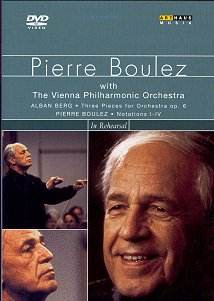Pierre
Boulez is one of the more famous composer/conductors in contemporary
music. Unlike some he excels in both spheres … unless of course
you don’t like his musical style. This DVD shows him working with
one of the top orchestras in the world in his own music and that
of a modern composer for which he has great sympathy. His conducting
style is very interesting. He sets off, and almost allows the
orchestra to play right through, as though there is nothing wrong.
He then returns to the start and meticulously rehearses tiny snippets
where he requires some change. How he is able to remember all
of the parts he wants to go over is beyond me. For example, when
massed brass is playing, he is able to pick out one player in
the mêlée who is playing a semi-tone out of tune.
He homes in on this poor individual, and you feel sure that he
will never play it wrong again. All this is done with a quiet
charm, there being no raised voices, just musicians working together
at the service of the composer.
My
usual complaint about rehearsal programmes such as this, is that
we do not get to hear the complete programme after it has been
rehearsed. So it is here, but because Boulez insists on playing
the work through almost complete at the beginning of the rehearsal,
we do at least get to hear the piece as interpreted by the orchestra.
And with an ensemble as good as the Vienna Philharmonic, the initial
run through is bound to be pretty good.
This
release comes with no notes, no recording location or any other
data except the playing time. Arthaus are to be castigated for
this. With a programme of this nature, some notes, even rudimentary
ones, would have been very useful, and easy to produce. Given
the prices of these DVDs this should be mandatory.
Alban
Berg had spent a week with Schoenberg in Berlin in 1913. He returned
in a state of extreme depression after having been told by his
mentor that he was deficient in the standards of his compositions,
his attitudes and his way of life. He had at this time also been
deeply affected by the failure of his "Altenberg Lieder",
such that they were never performed again in public during Berg’s
lifetime. Taking Schoenberg’s criticisms to heart, Berg began
to write a Symphony intending it to be a large work. Unfortunately
it stubbornly refused to materialise, and upon another comment
from Schoenberg, he recast much of the material into a three movement
work which eventually became the Three Pieces, Op. 6. These were
sent to Schoenberg as a present for his 40th birthday
on 13th September 1914. The unfinished central movement
was completed and sent to Schoenberg during the following summer.
These are the most complicated pieces written by the composer,
and it is necessary to have a conductor well versed in the idiom
to make them sound more than a cacophony, which they could otherwise
easily become. Boulez spends his time efficiently and very soon,
the work starts to emerge as, one would hope, the composer intended.
When
we turn to the Boulez pieces, we have the composer in front of
the ensemble. The direction should be accurate, and so it is.
The four notations are a reworking of the composer’s earlier work
for piano Notations 1 – 12. Returning to these some thirty years
later, Boulez completely rewrote them and turned them into an
orchestral composition at once complex and demanding, showing
a development of the material in a short time-frame. See if you
can get to grips with them. I had difficulty, but it was a fascinating
journey.
I
would recommend this disc to anyone who wants to learn a bit more
about contemporary orchestral music; contemporary? … nearly a
century has elapsed since the Berg was originally composed.
John
Phillips
